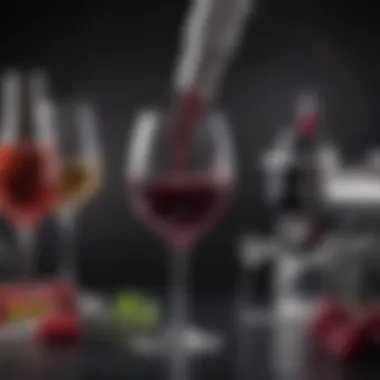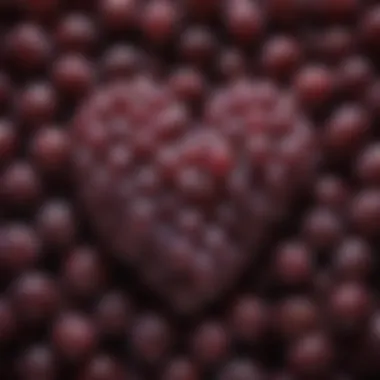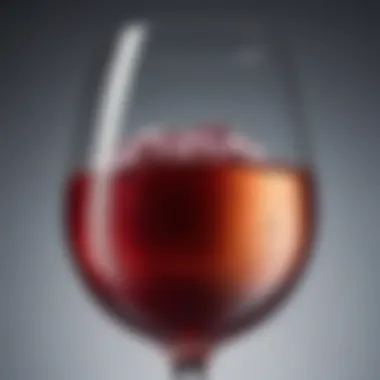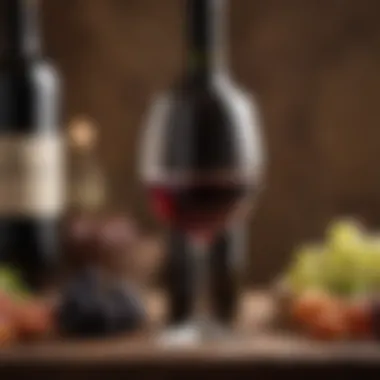Understanding the Science of Dealcoholized Wine Production


Intro
The rise of dealcoholized wine in recent years reflects broader trends catering to a health-conscious consumer base. As society becomes increasingly aware of the implications of alcohol consumption, many are searching for alternatives that provide both flavor and sensory satisfaction without the intoxicating effects. This article explores the complex process and scientific principles behind dealcoholized wine production.
By employing advanced techniques, winemakers strive to retain the essential character and nuanced flavors of traditional wine while eliminating alcohol content. The ensuing discussion will unpack the historical context, explore the methodologies, and consider the implications for consumers seeking indulgence without alcohol.
Understanding the nuances of dealcoholized wine requires a look into its intricacies. Through an examination of technology, consumer preferences, and historical practices, readers will gain valuable insights into this evolving beverage category.
Preamble to Dealcoholized Wine
Dealcoholized wine has become a significant topic in wine production. It reflects changing consumer preferences and increased health consciousness. As more individuals lean towards healthier lifestyles, the demand for alcohol-free options continues to grow. Understanding this phenomenon requires a look at both the methods used and the appeal behind dealcoholized wine. This article will explore these essential elements.
Definition and Overview
Dealcoholized wine refers to wine that undergoes a process to remove most of its alcohol content while trying to retain the original flavor. The final product typically contains less than 0.5% alcohol, aligning it with regulations for non-alcoholic beverages. It aims to provide the sensory experience of traditional wine without the effects associated with alcohol consumption.
The process of creating dealcoholized wine involves sophisticated techniques that safeguard the aromatic compounds inherent in wine. This process can be attractive not only to those who wish to avoid alcohol for personal or health reasons but also to people interested in alternative flavors and experiences associated with wine enjoyment.
Historical Context of Wine Consumption
Wine has played a vital role in many cultures throughout history. It served religious, culinary, and social functions dating back thousands of years. However, the evolution of wine consumption has seen shifts in perception influenced by cultural, health, and legal variables.
Historically, wine drinking was tied to various societal customs and often included higher levels of alcohol than many would tolerate today. The growth in awareness regarding alcohol-related health issues has led to increased scrutiny of drinking habits. As a result, there is an acknowledgment that not everyone desires or can consume alcohol at all. This shift highlights the importance of wine alternatives.
"The trend towards non-alcoholic beverages is not just about prohibition but about expanding choices for discerning consumers."
Over the years, innovations in wine production methods have mirrored changes in consumer attitudes. As tastes have evolved, the demand for options like dealcoholized wine has escalated. Recognizing this historical context helps appreciate the current landscape of wine consumption and its significance in society.
Understanding Wine Production
Understanding the process of wine production is crucial to appreciate the uniqueness of dealcoholized wine. It informs us of how the flavors, aromas, and other characteristics of wine are developed before the alcohol is removed. This knowledge helps in appreciating the complexities involved in creating a product that not only adheres to the essence of traditional wine but also caters to a growing market seeking non-alcoholic options. The stakes are high, as the intricacies of winemaking directly influence the final product's sensory quality.
The Basics of Winemaking
Winemaking, or vinification, is an age-old craft that requires attention to detail and a deep understanding of natural processes. This process can be divided into several fundamental stages, each playing a vital role in shaping the final outcome.
- Harvesting: Grapes must be picked at the right time to ensure optimal sugar and acid levels. This moment varies depending on the type of grape and climate.
- Crushing and Pressing: After harvesting, grapes are crushed to release their juice. For white wines, the skins are separated immediately to avoid color and tannin extraction.
- Fermentation: Yeast is added to the grape juice, converting sugars into alcohol and carbon dioxide. This stage dramatically impacts flavor and aroma, taking anywhere from a few days to several weeks.
- Aging: The wine is then aged in various containers, such as stainless steel tanks or oak barrels. Aging affects flavor complexity, with oak contributing notes of vanilla, spice, and more.
- Bottling: Once the desired characteristics are achieved, the wine is filtered, sometimes blended with others, and then bottled.
Through these stages, winemakers can create diverse styles that vary in sweetness, acidity, and body, catering to a wide spectrum of palates. This foundational knowledge is essential when discussing how dealcoholization methods retain these qualities while eliminating alcohol.
Key Components of Wine
Wine is a complex beverage composed of various components, each contributing to its overall profile. Recognizing these components is important for understanding how dealcoholization affects the final product.
- Water: Makes up about 85-90% of wine, and its purity influences taste.
- Alcohol: Ethanol constitutes about 8-15% of wine's volume. It impacts mouthfeel and aroma.
- Acids: Tartaric and malic acids provide balance and freshness. They also preserve wine, inhibiting spoilage.
- Sugars: Natural sugars contribute to sweetness levels, influencing wine style.
- Phenolics: These compounds, including tannins, affect color, mouthfeel, and aging potential. They come from grape skins, seeds, and stems.
- Aroma Compounds: Various volatile compounds contribute to the distinct fragrances of different wine types. They are vital for sensory perception.
By grasping these foundational elements, we can better appreciate the challenges faced in retaining these characteristics in dealcoholized wines. The methods of dealcoholization must carefully consider each of these components to ensure quality and consumer satisfaction.
Methods of Dealcoholization


The process of dealcoholization plays a critical role in the production of dealcoholized wine. It combines science and technology to achieve the delicate balance of flavor retention while removing alcohol. There are several established methods, each with its unique characteristics. Understanding these methods is essential for wine producers aiming to cater to a growing audience seeking non-alcoholic options.
Vacuum Distillation
Vacuum distillation is a process that lowers the boiling point of liquid through reduced pressure. This method allows for the extraction of alcohol at a lower temperature, which helps to preserve sensitive aromatic compounds in wine. The wine is heated gently in a vacuum chamber, and alcohol evaporates, separating from the remaining liquid.
This technique is particularly valued because it maintains the integrity of flavors. It is less invasive than traditional distillation and minimizes the risk of altering the overall sensory profile of the wine. Many producers prefer vacuum distillation for its effectiveness in flavor retention.
Reverse Osmosis
Reverse osmosis is a filtration process that uses a semi-permeable membrane to separate substances based on their size and molecular weight. In the context of dealcoholized wine, the wine is passed through this membrane under pressure, allowing water and small molecules like alcohol to pass while retaining larger compounds like flavors and colors.
This method is efficient and can be adjusted based on desired characteristics in the final product. However, the equipment required is more complex and costly, which can affect production decisions. Nonetheless, reverse osmosis is gaining popularity due to its ability to produce high-quality dealcoholized wines.
Spinning Cone Column Technology
Spinning cone column technology involves creating a whirlwind effect to separate components in the wine. This technology uses centrifugal force to enhance the efficiency of the extraction process. Wine is introduced into the column, where it comes into contact with specially designed cones that facilitate the removal of alcohol while preserving aromatic compounds.
The beauty of this method lies in its precision. It allows producers to better control the extraction variables, ensuring that the sensory compounds remain intact. Wines treated with spinning cone technology can maintain their flavor integrity, a significant aspect for discerning consumers.
The Role of Heat Exchange
Heat exchange plays a vital role in many dealcoholization methods. By controlling temperature, producers can optimize alcohol removal while safeguarding the flavors present in the wine. Understanding how heat impacts both aromas and taste ensures that the final product doesn’t lose its desired characteristics.
Proper management of heat during the dealcoholization process is essential. If the temperature is too high, it can lead to the loss of volatile compounds, resulting in an unbalanced flavor profile. Conversely, too low of a temperature may not fully remove the alcohol, affecting the wine's overall quality.
The choice of dealcoholization method significantly influences the sensory experience of the consumer. Different techniques yield varying results, impacting taste, aroma, and the overall perception of dealcoholized wines.
These methods illustrate the intricate science behind producing dealcoholized wines. As the market for non-alcoholic beverages continues to grow, the importance of understanding these processes increases for both producers and consumers.
The Science of Flavor Retention
The process of dealcoholization in wine goes beyond merely stripping alcohol from the beverage. A primary focus is on the science of flavor retention. Flavor is a complex interplay of various compounds, and keeping these intact is crucial to maintaining the quality of the wine. Optimum flavor retention involves understanding how different processes affect these compounds. Advances in technology have made it possible to better preserve the wine’s flavor while still achieving low alcohol levels, thus catering to a growing consumer demand for healthier options without compromising experience.
Preserving Aromatic Compounds
Aromatic compounds play a foundational role in the overall experience of wine. These compounds influence aroma, taste, and even mouthfeel. During dealcoholization, one must consider how different methods impact these critical components. For instance, techniques like vacuum distillation and reverse osmosis are designed to minimize the loss of these volatile compounds.
- Volatile Aromatic Compounds: These are sensitive, and high heat can lead to their breakdown. Therefore, gentle processing techniques are essential.
- Preservation Techniques: Some producers use cold stabilization and other methods to retain aromatic strength. This requires precision and knowledge about the chemistry of these compounds.
- Consumer Preference: Studies show that consumers associate more aromatic profiles with higher quality. Thus, producers must prioritize this aspect to appeal to customers.
In summary, aromatic compounds must be carefully preserved to create a product that does not feel deficient in aroma, even with a reduced alcohol level.
The Impact of Alcohol on Flavor Profile
Alcohol itself contributes to the flavor profile of wine. It functions as a solvent for various phenolic and aromatic compounds, enhancing perceived flavors and mouthfeel. Therefore, removing alcohol alters this dynamic significantly.
- Weight and Balance: Alcohol adds weight and body; hence, dealcoholized wines often feel lighter. Consumers might notice a difference in texture, which can shape their perception of quality.
- Flavor Perception: Alcohol influences the volatile release of flavors. The absence of alcohol can cause a less intense experience of fruitiness or spiciness, making it vital to compensate with other methods like enhancing acidity or boosting other components.
- Consumer Acceptance: Taste tests reveal that not all consumers prefer dealcoholized wine, primarily due to altered flavor profiles. Educating consumers regarding what to expect can help bridge this gap.
Sensory Analysis of Dealcoholized Wine
Sensory analysis is a crucial aspect of evaluating dealcoholized wine. As consumers increasingly seek alternatives to traditional alcoholic beverages, understanding how these wines appeal to the senses becomes essential. This analysis focuses on the sensory properties, such as taste, aroma, and mouthfeel, that distinguish dealcoholized wine from its alcoholic counterparts. Assessing these aspects helps producers enhance quality and guides consumers in making informed choices.


Taste and Aroma Assessment
The assessment of taste and aroma in dealcoholized wine is vital for several reasons. Firstly, the flavor profile significantly influences consumer preferences and perceptions. Many individuals transition to dealcoholized wine seeking the same richness and complexity found in conventional wines. Therefore, evaluators often focus on the balance of sweetness, acidity, and bitterness. Notably, sweetness can often be higher in dealcoholized wines to compensate for the absence of alcohol, which generally contributes to a wine’s overall mouthfeel.
Aroma is equally important, as it completes the sensory profile. Aromatic compounds can be affected during the dealcoholization process. Techniques like spinning cone column technology aim to preserve these elements. Evaluators often describe aromas using a range of descriptors, from fruity to floral. This diversity allows them to ascertain how well the dealcoholized version retains the wine’s original aromatic characteristics.
Consumer Perceptions
Consumer perceptions of dealcoholized wine are shaped by both the sensory analysis and cultural trends. Many consumers approach these wines with preconceived notions based on their past experiences with alcoholic wines. It’s essential to note that perceptions can vary widely among different demographics. Younger consumers display a more adventurous attitude towards trying dealcoholized options, often emphasizing health and wellness benefits.
Furthermore, educational efforts can help reshape perceptions. Informing consumers about production methods can enhance appreciation for the craftsmanship behind dealcoholized wine. Providing tasting notes or pairing suggestions can improve their overall experience and acceptance of these wines. Addressing misconceptions about flavor and fragrance is especially important, as many consumers initially believe that dealcoholized wines cannot match the quality of their alcoholic counterparts.
Health Considerations
The context of health considerations regarding dealcoholized wine is significant. As society becomes increasingly aware of health and wellness, many people are seeking alternatives to traditional alcoholic beverages. Dealcoholized wine serves as a bridge, offering the familiar taste and experience of wine without the intoxicating effects associated with alcohol. This section explores the nutritional content and the benefits and drawbacks that consumers should consider when choosing dealcoholized wine.
Nutritional Content of Dealcoholized Wine
The nutritional profile of dealcoholized wine is often seen as a deciding factor for many consumers. Generally, dealcoholized wines contain low calories and fewer carbohydrates compared to their alcoholic counterparts. This can be particularly appealing for those monitoring their caloric intake or following dietary restrictions.
For example, a typical serving of traditional red wine may have approximately 125 calories. However, a comparable serving of dealcoholized red wine contains around 30 to 50 calories. This reduction is mainly due to the absence of alcohol, which is calorie-dense. Furthermore, dealcoholized wines often contain beneficial compounds like antioxidants, including resveratrol, which is linked to heart health.
The nutrient composition can vary significantly by brand and production methods. Therefore, it is essential for consumers to check labels for specific nutritional information. Here is a general comparison of nutritional aspects between alcoholic and dealcoholized wine:
- Calories: Lower in dealcoholized wine.
- Carbohydrates: Reduced levels.
- Antioxidants: Presence may vary, but some retain health benefits.
"Many dealcoholized wines successfully preserve certain healthful properties of traditional wines while significantly lowering calories and alcohol content."
Benefits and Drawbacks for Consumers
When considering dealcoholized wine, one can identify several benefits and drawbacks. Understanding these can help consumers make informed choices about their beverage options.
Benefits:
- Reduced Alcohol Intake: For individuals seeking to limit their alcohol consumption, dealcoholized wine is a favorable alternative. It allows for social interaction without the effects of intoxication.
- Health Benefits: Some studies suggest that moderate consumption of wine may result in health benefits due to antioxidants. Dealcoholized wine can provide similar compounds without the associated alcohol-related risks.
- Diverse Flavor Options: The market for dealcoholized wines continues to grow, providing a range of choices for various tastes. This allows consumers to explore different flavor profiles while maintaining a non-alcoholic option.
Drawbacks:
- Flavor Differences: Some consumers may notice a difference in taste when compared to traditional wine. The process of dealcoholization can alter certain flavor profiles, which might not meet every wine enthusiast's expectations.
- Nutritional Misconceptions: The perception that all dealcoholized wines are inherently healthy may not be accurate. Consumers must scrutinize labels to understand the comprehensive nutritional content.
- Limited Understanding: There remains a general lack of awareness regarding dealcoholized wines. Some consumers may be hesitant to try these options simply because they are unfamiliar with them.
In summary, dealcoholized wine represents a significant alternative for health-conscious consumers. While exploring its nutritional content and weighing the benefits against the drawbacks, one can appreciate its place in the modern beverage landscape.
Market Trends and Consumer Demand
The rise of dealcoholized wine reflects a shift in consumer preferences, focusing on health-conscious choices and a growing interest in unique beverage options. Understanding market trends gives valuable insight into how dealcoholized wine is not just a niche product but a segment rapidly gaining momentum in the broader beverage market. Consumers are increasingly seeking alternatives that maintain social rituals without the effects of alcohol. This trend highlights the importance of responding to evolving consumer demands in the beverage industry, particularly among wine producers.
Growth of the Non-Alcoholic Beverage Market
The non-alcoholic beverage market has experienced remarkable growth in recent years, driven by changing lifestyles and attitudes towards alcohol consumption. This segment is not only limited to soft drinks but also encompasses an impressive variety of beverages, including dealcoholized wine. The current market reports a significant rise, with some estimates indicating a growth rate of over 7% per year.
Factors contributing to this expansion include:


- Health Awareness: Increased awareness of health and wellness encourages many to reduce alcohol intake while still desiring enjoyable flavors.
- Cultural Shifts: Younger consumers are increasingly inclined to participate in social settings without alcohol. They seek inclusive options that align with their lifestyle choices.
- Availability: Brands are responding to demand by creating a diverse range of dealcoholized wines, improving accessibility and variety.
As the market continues to grow, producers are investing in innovative techniques to enhance both the taste and quality of dealcoholized wine. This evolution creates opportunities for wineries to capture a broader audience, catering to those seeking lifestyle balance without sacrificing flavor.
Demographic Insights
To better understand who is driving this market trend, demographic insights provide important context. Research indicates the following key demographics embracing dealcoholized wine:
- Millennials and Gen Z: These younger generations show a strong preference for low-alcohol or dealcoholized options, driven by health consciousness and a desire for mindful drinking.
- Health-Conscious Consumers: Older populations concerned about health-related issues, such as high blood pressure or liver disease, find dealcoholized wine appealing as a safer alternative.
- Sociocultural Factors: Women, in particular, are significant consumers in the dealcoholized wine segment, often prioritizing products that align with healthy lifestyles while enjoying social experiences.
This rapidly shifting demographic landscape indicates that the future of wine consumption is likely to be influenced by younger, health-conscious consumers, along with those who are re-evaluating their relationship with alcohol. The industry must remain adaptable to meet the evolving tastes and preferences of these discerning individuals.
"The changes in consumer demand necessitate an evolution in product offerings, ensuring that all sectors of society find enjoyment in dealcoholized wine that suits their lifestyles."
In summary, the increasing prominence of dealcoholized wine within the non-alcoholic beverage market highlights its relevance in contemporary consumption patterns. Understanding market trends and demographic insights will be critical for producers looking to thrive in this lucrative and expanding segment.
The Future of Dealcoholized Wine
The future of dealcoholized wine presents an intriguing landscape shaped by innovation, evolving consumer preferences, and broader trends in health and wellness. As more individuals seek alternatives that enhance their lifestyle while still providing the experience of traditional wine consumption, the demand for dealcoholized options is likely to grow significantly. This evolution is not merely about containing alcohol, but about preserving quality, flavor, and the cultural significance of wine.
Innovations in Production Techniques
Advancements in technology are crucial to the production of high-quality dealcoholized wine. Methods such as spinning cone column technology and vacuum distillation have shown great promise. These innovations enable winemakers to lower alcohol levels effectively while retaining essential aromas and flavors.
Moreover, researchers are constantly exploring enzymatic treatments that can further enhance the sensory attributes of dealcoholized wine. These techniques help ensure that the resulting product resonates with traditional wine's complexity and richness. The integration of new technologies will likely allow for more precise modifications, making it possible to tailor flavors to specific consumer tastes.
Additional emerging methods, such as membrane filtration, are also gaining interest. This approach separates alcohol with minimal impact on other wine components. The continuous development in this area provides winemakers powerful tools for production.
Potential Market Expansion
As the cultural perception of alcohol evolves, there is a significant opportunity for dealcoholized wine to capture an expanding market. Health-conscious consumers, including millennials and Gen Z, are championing the decade’s movement towards lower alcohol consumption. This demographic shift has created a fertile ground for the growth of non-alcoholic beverages, including dealcoholized wine.
Market research indicates an upward trend in sales of non-alcoholic wines. This brings not only a wider selection to consumers but also potential partnerships and collaborations within the beverage industry. Brands that previously focused solely on alcoholic products may seek to diversify and embrace the trend of dealcoholization as part of their strategic agenda.
Furthermore, international markets are beginning to show interest, heralding an expanded consumer base. Countries with a rich tradition of wine may find that dealcoholized versions can cater to interests in health and moderation without losing cultural ties to their wine heritage.
This trend reflects a broader movement toward mindful drinking, where consumers look to enjoy wine without the adverse effects of alcohol.
Overall, the landscape of dealcoholized wine appears promising, with innovations guiding production and cultural shifts driving market expansion. Brands that can navigate this terrain effectively will likely lead the way in the changing dynamics of wine consumption.
The End
Dealcoholized wine represents a significant evolution in the winemaking industry, blending tradition with modern health-conscious trends. This conclusion underscores the importance of understanding the various elements that define this product and the broader implications for consumers.
Recapitulation of Key Points
Throughout this article, several crucial aspects have emerged:
- Historical Evolution: The journey of wine has transformed significantly, and the emergence of dealcoholized wine fits within long-standing cultural practices.
- Production Methods: Various methods like vacuum distillation and reverse osmosis illustrate the sophisticated techniques used to reduce alcohol while preserving flavor.
- Flavor Science: Understanding the balance between the removal of alcohol and the retention of aromatic compounds is key in maintaining the wine's integrity.
- Health Considerations: Dealcoholized wine offers health benefits, appealing to consumers wanting to enjoy wine without its intoxicating effects.
- Market Trends: The growth in the non-alcoholic beverage market and demographic shifts reflect changing consumer preferences and desires.
- Future Innovations: Advances in production techniques indicate a promising trajectory for further developments in dealcoholized wine.
Final Thoughts on Dealcoholized Wine
The ongoing advancements in production and an understanding of consumer needs will likely shape its future. As production methods become more refined, the sensory experience associated with dealcoholized wines may improve, further blurring the lines between conventional and dealcoholized offerings.
"The intersection of tradition and modernity in winemaking continues to evolve. Dealcoholized wine is more than a mere alternative; it is a testament to the adaptability of wine culture in a changing world."
In essence, dealcoholized wine stands as an important alternative in today's beverage landscape, expanding choices and enabling enjoyment for different lifestyles. Its relevance in modern dining and social contexts cannot be understated.







